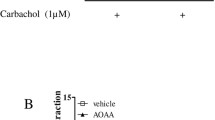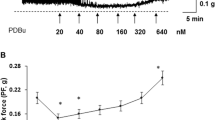Abstract
Objective
We studied the effect of increased hydrostatic pressure on muscarinic (M) receptor expression in isolated human bladder smooth muscle cells (HBSMCs) and in an in vivo model of acute bladder outlet obstruction (BOO). We evaluated additionally whether acetylcholine functions as BSMCs mitogen.
Methods
HBSMCs were exposed to sustained levels of increased hydrostatic pressure. Expression of the M2 and M3 receptors was measured by Western blot analysis. Acute BOO was maintained in five male pigs for 24 h; six normal animals served as controls. Expression of the M2 and M3 in tissues was evaluated in a similar fashion to the isolated cells. HBSMCs were subsequently exposed to 100 μM acetylcholine in the presence or absence of hydrostatic pressure. DNA and protein synthesis were measured using a 3H-tymidine and leucine incorporation assay, respectively.
Results
Mean (range) detrusor pressure in acute BOO and controls was 19 (1–36.1) and 3.1 (1–16) cm-H2O, respectively. M2 and M3 receptor expression in HBSMCs increased in a time-dependent and pressure-dependent manner. Both M2 and M3 expressions in BOO model were markedly upregulated when compared to controls. Compared to controls, thymidine and leucine incorporation in HBSMCs demonstrated a significant increase following exposure to 100 μM acetylcholine and/or 40 cm-H2O.
Conclusions
M2 and M3 receptors are upregulated in a time-dependent and pressure-dependent fashion after as little as a 24 h exposure to increased hydrostatic pressure. Acetylcholine has a more profound proliferative effect when cells are simultaneously exposed to increased levels of hydrostatic pressure.




Similar content being viewed by others
References
McGuire EJ, Woodside JR, Borden TA et al (2002) Prognostic value of urodynamic testing in myelodysplastic patients. J Urol 167:1049–1053
Kaefer M, Pabby A, Kelly M et al (1999) Improved bladder function after prophylactic treatment of the high risk neurogenic bladder in newborns with myelomeningocele. J Urol 162:1068–1071
Backhaus BO, Kaefer M, Haberstroh KM et al (2002) Alterations in the molecular determinants of bladder compliance at hydrostatic pressures less than 40 cm. H2O. J Urol 168:2600–2604
Haberstroh KM, Kaefer M, Retik AB et al (1999) The effects of sustained hydrostatic pressure on select bladder smooth muscle cell functions. J Urol 162:2114–2118
Guizzetti M, Costa P, Peters J et al (1996) Acetylcholine as a mitogen: muscarinic receptor mediated proliferation of rat a astrocytes and astrocytoma cells. Eur J Pharma 297:265–273
Shaw MBK, Jung C, Cain MP, et al (2003) Heparin-binding epidermal growth factor-like growth factor induces hypertrophy in human bladder smooth muscle cells. BJU Int 91(Suppl 1):39, abstract E-56
An JY, Yun HS, Lee YP et al (2002) The intracellular pathway of the acetylcholine-induced contraction in cat detrusor muscle cells. Br J Pharmacol 137:1001–1010
Yamanishi T, Chapple CR, Yasuda K et al (2002) The role of M2 muscarinic receptor subtypes in mediating contraction of the pig bladder base after cyclic adenosine monophosphate elevation and/or selective M3 inactivation. J Urol 167:397–401
Braverman AS, Ruggieri MR Sr (2003) Hypertrophy changes the muscarinic receptor subtype mediating bladder contraction from M3 toward M2. Am J Physiol Regul Integr Comp Physiol 285:R701–R708
Tobin AB, Nahorski SR (1993) Rapid agonist-mediated phosphorylation of M3-muscarinic receptors revealed by immunoprecipitation. J Biol Chem 268:9817–9823
Igawa Y (2000) Discussion: functional role of M(1), M(2), and M(3) muscarinic receptors in overactive bladder. Urology 55(5A Suppl):47–49
Hegde SS, Eglen RM (1999) Muscarinic receptor subtypes modulating smooth muscle contractility in the urinary bladder. Life Sci 64:419–428
Eglen RM, Hegde SS et al (1996) Muscarinic receptor subtypes and smooth muscle function. Pharmacol Rev 48:531–565
Kories C, Czyborra C, Fetscher C et al (2003) Gender comparison of muscarinic receptor expression and function in rat and human urinary bladder: differential regulation of M2 and M3 receptors? Naunyn Schmiedebergs Arch Pharmacol 367:524–531
Luetje CW, Brumwell C, Norman MG et al (1987) Isolation and characterization of monoclonal antibodies specific for the cardiac M acetylcholine receptor. Biochemistry 26:6892–6896
Buck MA, Fraser CM (1990) Muscarinic acetylcholine receptor subtypes which selectively couple to phospholipase C: pharmacological and biochemical properties. Biochem Biophys Res Commun 173:666–672
Emir H, Eroglu E, Tekant G et al (2002) Urodynamic findings of posterior urethral valve patients. Eur J Pediatr Surg 12:38–41
Sibley GN (1985) An experimental model of detrusor instability in the obstructed pig. Br J Urol 57:292–298
Conflict of interest statement
There is no conflict of interest.
Author information
Authors and Affiliations
Corresponding author
Additional information
Supported by grants from the Showwalter Foundation, Robert Garrett Professorship, and Riley Memorial Foundation, Indiana University, and from The Medical Research Institute of Pusan National University.
Rights and permissions
About this article
Cite this article
Lee, S.D., Misseri, R., Akbal, C. et al. Muscarinic receptor expression increases following exposure to intravesical pressures of ≤40 cm-H2O: a possible mechanism for pressure-induced cell proliferation. World J Urol 26, 387–393 (2008). https://doi.org/10.1007/s00345-008-0268-x
Received:
Accepted:
Published:
Issue Date:
DOI: https://doi.org/10.1007/s00345-008-0268-x




